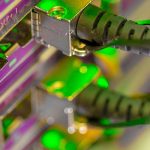In recent months, we’ve seen some impressive advancements in quantum computing technology, highlighting how fast things are changing in this field. We’re still in the early stages, mostly in academic labs working on error correction, but businesses are laying out plans that suggest commercial machines are on the horizon.
Take IBM, for example. Their roadmap indicates they’ll transition from the Heron machine to a new device called Flamingo this year. Flamingo connects two Heron devices together, thanks to a technology called L-couplers, which they showcased at their first quantum computing developer conference in November 2024. These L-couplers link two Heron R2 chips with connectors up to a meter long. IBM aims to boost the number of quantum gates from 5,000 to 15,000 by 2028 using a modular approach.
Then there’s Microsoft, which recently released research on topological qubits known as Majorana fermions. They believe these could lead to more stable qubits that need less error correction. Microsoft is also working on a device called Majorana 1 to help detect those qubits and run quantum computations effectively.
Will Ashford-Brown from Heligan Group shared his insight: “Every day we’re getting closer to commercial quantum use in real applications. We’re looking at improvements in size, cooling, price, speed, and impact. It seems like commercial opportunity is just around the corner.” He expects demand for quantum platforms to rise soon, moving beyond the national labs to tech giants like Microsoft, Amazon, Google, and IBM, all of whom are teaming up with quantum startups for cloud services or developing their own systems.
On the industrial side, companies are exploring hybrid methods to leverage quantum computing for complex computations. D-Wave has ramped up its quantum optimization services. Notably, Ford Otosan, a collaboration between Ford and Koç Holding in Turkey, has implemented a hybrid quantum application using D-Wave technology, enhancing its manufacturing processes.
The U.S. has embarked on an eight-year initiative to make quantum computing practically useful. The Department of Defense selected ten companies—like Alice & Bob, Quantinuum, and Rigetti—to kick off the Quantum Benchmarking Initiative. This project aims to determine if we can build a useful quantum computer by 2033.
These examples are just a glimpse of the substantial efforts happening in the tech world to improve quantum computing and hybrid architectures. Graeme Malcolm, CEO of M Squared Lasers, sees the need for a strong push toward commercialization. He warned that we’re on the verge of what’s dubbed the “quantum valley of death,” a critical shift from research to real-world applications.
With the government’s recent funding boost of £121 million for quantum technology development in the UK, Malcolm stressed: “It’s time for us to focus on industrialization. A nation without quantum will lack a critical edge.”
Yet, despite the strides being made, a recent survey from Economist Impact found that 57% of participants feel misconceptions about quantum computing are stalling progress. This suggests a gap between tech advancements and business readiness, emphasizing the need for better communication and education to keep up the momentum.
Helen Ponsford of Economist Impact highlighted that 80% of respondents believe showcasing industry-specific use cases is crucial for speeding up adoption, while two-thirds underscored the importance of proving ROI. It’s clear that commercial relevance has to keep up with scientific breakthroughs for quantum to thrive.
Lastly, while we’ve made strides in making quantum technology accessible to developers, we can’t overlook the security challenges that need addressing before mass adoption. Daniel Shiu, chief cryptographer at Arqit, pointed out the urgency: “The timeline for viable quantum computers is uncertain, but it’s clear the industry is making progress, and the threat is already here. Any systems compromised now could be vulnerable once quantum machines arrive. We have to focus on quantum security now.”





